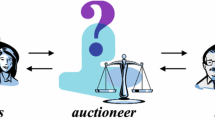Abstract
Spectrum sharing has emerged as a promising solution to address the radio frequency spectrum bottleneck. The FCC has recently proposed a spectrum sharing framework that introduces a spectrum access system as the governing entity that manages access to spectrum for primary and secondary users to coexist. An important aspect of dynamic spectrum management is the pricing of spectrum from the perspective of both the primary and secondary users. Existing auction-based spectrum sharing models do not take into consideration an important aspect of successful secondary user operation: the duration of the available spectrum opportunity. In this paper we propose an auction-based spectrum sharing framework that statistically accounts for the accuracy of the estimates of spectrum availability duration. The proposed auctioning process allows both the PU and the SU to iteratively adjust their evaluation about the available spectrum opportunities over time and to achieve a price combination that maximizes their objectives. A method is proposed to statistically assure spectrum availability, supplementing the reporting method. Hidden Markov models and non-stationary hidden Markov models are used to estimate the activity of the spectrum, with simulation results showing high prediction accuracy.










Similar content being viewed by others
References
Ericsson, A. (2014). Interim ericsson mobility report.
Commission, F. C. (2012). FCC NPRM in the matter of amendment of the commission’s rules with regard to commercial operations in the 3550–3650 MHz band. Washington, D.C.
T. E. T. S. Institute (2013). ETSI TR mobile broadband services in the 2300–2400 MHz frequency band under licensed shared access regime. ETSI.
PCAST (2012). Report to the president: Realizing the full potential of government-held spectrum to spur economic growth. Washington, D.C.
F. C. Commission (2004). Notice of proposed rulemaking, in the matter of unlicensed operation in the TV broadcast bands (ET Docket No. 04-186) and additional spectrum for unlicensed devices below 900 MHz and in the 3 GHz band (ET Docket No. 02-380). FCC 04-113.
A. NTIA (2010). Assessment of the near-term viability of accommodating wireless broadband systems in the 1675–1710 MHz, 1755–1780 MHz, 3500–3650 MHz, 4200–4220 MHz, and 4380–4400 MHz Bands.
Benmammar, B., Amraoui, A., & Krief, F. (2013). A survey on dynamic spectrum access techniques in cognitive radio networks. International Journal of Communication Networks and Information Security, 5, 68.
F. C. Commission (2014). FNPRM: Ammendment of the commission’s rules with regard to commercial operations in the 3550–3650 MHz band. Washington, D.C.
Zhao, Q., & Sadler, B. M. (2007). A survey of dynamic spectrum access. Signal Processing Magazine, IEEE, 24, 79–89.
Yucek, T., & Arslan, H. (2009). A survey of spectrum sensing algorithms for cognitive radio applications. Communications Surveys and Tutorials, IEEE, 11, 116–130.
Huang, S., Liu, X., & Ding, A. Z. (2008). Opportunistic spectrum access in cognitive radio networks. In The 27th conference on computer communications.
Xin, C., Song, M., Ma, L., Hsieh, G., & Shen, C.-C. (2010). On random dynamic spectrum access for cognitive radio networks. In Global telecommunications conference.
Zhang, Y. (2008). Dynamic spectrum access in cognitive radio wireless networks. In ICC.
Felegyhazi, M., & Hubaux, J.-P. (2006). Game theory in wireless networks: A tutorial no. LCA-REPORT-2006-002.
Niyato, D., & Hossain, E. (2007). A game-theoretic approach to competitive spectrum sharing in cognitive radio networks. In IEEE wireless communications and networking conference.
Ali, R. E., Seddik, K. G., Nafie, M., & Digham, F. F. (2013). A pricing-based cooperative spectrum sharing Stackelberg game. Preprint.
Mwangoka, J. W., Letaief, K. B., & Cao, Z. (2009). Joint power control and spectrum allocation for cognitive radio networks via pricing. Physical Communication, 2, 103–115.
Niyato, D., & Hossain, E. (2008). Competitive pricing for spectrum sharing in cognitive radio networks: Dynamic game, inefficiency of nash equilibrium, and collusion. IEEE Journal on Selected Areas in Communications, 26, 192–202.
Mohammadian, H. S., & Abolhassani, B. (2010). Auction-based spectrum sharing for multiple primary and secondary users in cognitive radio networks. In Sarnoff symposium. IEEE.
Daoud, A. A., Alpcan, T., Agarwal, S., & Alanyali, M. (2008). A Stackelberg game for pricing uplink power in wide-band cognitive radio networks. In 47th IEEE conference on decision and control.
Sun, J., Modiano, E., & Zheng, L. (2006). Wireless channel allocation using an auction algorithm. IEEE Journal on Selected Areas in Communications, 24, 1085–1096.
Brenner, D. R. (2013). Comments of Qualcomm Inc. In The matter of amendment of the commission’s rules with regard to commercial operations in the 3550–3650 MHz Band. FCC.
Sohul, M. M., Ma, X., Yang, T., & Reed, J. H. (2014). Quality of service assurance for shared spectrum systems. In Military communications conference (MILCOM), IEEE.
Goldsmith, A. J., & Chua, S.-G. (1997). Variable-rate variable-power MQAM for fading channels. IEEE Transactions on Communications, 45, 1218–1230.
Sengupta, A., Amuru, S., Tandon, R., Buehrer, R. M., & Clancy, T. C. (2014) Learning distributed caching strategies in small cell networks. In 2014 11th international symposium of wireless communications systems (ISWCS).
Liu, T., Lemeire, J., & Yang, L. (2014). Proper initialization of hidden Markov models for industrial applications. In 2014 IEEE China summit & international conference on signal and information processing (ChinaSIP).
Yu, S.-Z., & Kobayashi, H. (2006). Practical implementation of an efficient forward–backward algorithm for an explicit-duration hidden Markov mode. IEEE Transactions on Signal Processing, 54, 1947–1951.
Abdallah, A., MacKenzie, A. B., Marojevic, V., Bacchus, R. B., Riaz, A., Roberson, D., et al. (2016). Detecting the impact of human mega-events on spectrum usage. In 13th IEEE annual consumer communications & networking conference (CCNC 2016).
Levinson, Stephen E. (1986). Continuously variable duration hidden Markov models for automatic speech recognition. Computer Speech and Language, 1(1), 29–45.
Author information
Authors and Affiliations
Corresponding author
Rights and permissions
About this article
Cite this article
Sohul, M.M., Yao, M., Abdallah, A.S. et al. Quality of service assurance-based auction for spectrum sharing systems. Analog Integr Circ Sig Process 91, 203–216 (2017). https://doi.org/10.1007/s10470-017-0932-4
Received:
Revised:
Accepted:
Published:
Issue Date:
DOI: https://doi.org/10.1007/s10470-017-0932-4




